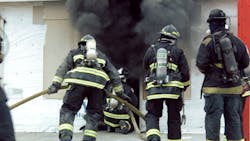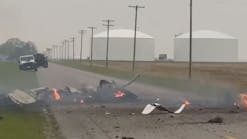IFSI Research Supplement: Tactical Considerations Related to Occupant Exposure
Following is Part 1 of the IFSI research supplement, sponsored by Globe. Download the full PDF of the supplement here.
Also, view the 10 Considerations Related to Cardiovascular & Chemical Exposure Risks supplement via Firehouse’s proprietary digital platform Clarity, which includes additional content and videos, here.
#1. Getting water on the fire
While UL FSRI and NIST have characterized water application from the exterior and interior of a structure for several years, this study offers an opportunity to compare changes in building temperatures and heat flux that result from firefighters conducting different attacks on the same structure. The variability in the way firefighters applied water mimicked typical fireground conditions that would be difficult to achieve in a controlled laboratory setting. Despite this variability, we found no evidence of increased air temperatures or heat flux at the end of the hallway just outside the two fire rooms, regardless of the direction from which water was applied. We also saw no evidence of spikes or abrupt change in gas concentrations at the simulated occupant locations that can be attributed to different water application techniques.
Importantly, earlier water application consistently resulted in reduced temperatures throughout the structure, lowering the temperatures in which firefighters operated from the front door and through the hallway. These lower temperatures produced only a minor reduction in firefighter skin temperature (neck skin temperature was approximately 1 degree F lower for transitional vs. interior attack) and had no significant impact on core temperature. However, the large ambient temperature reductions can impact occupant tenability within the structure, particularly if an occupant is behind a closed door and will need to be rescued through the interior of the structure (see Consideration #3). Although the transitional attack did not result in significant reductions in heat stress to firefighters, the tactic may have important implications for occupant rescue.
2. The value of the hollow core door
Newer furnishings, homes with more open layouts and modern construction materials allow fires to spread and produce toxic gases much faster, reducing the escape time for occupants. A closed door can offer a layer of protection between people and a fire, and this is important to remember for both occupants and firefighters. Public education messages underscore that if you can’t get out, put a closed door between you and the fire to buy valuable time. Sleeping with bedroom doors closed can also buy time to react to a sounding alarm.
In our study, we set up two bedrooms within the structure that were fitted with hollow core interior doors and remained closed throughout the burn. The door to one of these rooms stood along the same hallway that connected to the two fully involved fire rooms. Upon approaching the scene, incident command found smoke and/or flames showing from at least two sides of the structure. However, tenable/survivable conditions were measured behind closed doors less than five feet from the entrance to the fire rooms. As firefighters entered the structure and moved to the hallway, temperatures at crouching level or typical bed height were 600–800 degrees F on the hallway side of the door, but less than 100 degrees F in the bedroom. Even the inexpensive hollow core doors used in this study withstood fire.
It is equally important to realize that the interior doors experienced significant thermal damage during every burn scenario. In some cases, the doors’ outward-facing skin was consumed and inward-facing skins were charred. Visible smoke could also be found leaking into the upper level of the room closest to the fire rooms late in some scenarios. Interior doors have an important—but limited—ability to withstand the thermal onslaught of this magnitude. This finding stresses the need for firefighters to rapidly identify safe havens for potentially trapped occupants and either apply water to the fire or conduct rapid search and rescue from these areas (preferably both!).
Stress the importance of closed doors to the public and fellow firefighters. For more information visit closeyourdoor.org
3. VEIS from the inside?
Vent, enter, isolate and search are each important fireground tasks that, while often taught independently, should be combined in a properly coordinated fashion to achieve success on the fireground. Using isolation during a systematic interior search can allow you to vent as you go without impacting the fire, while making search conditions more favorable. It can also provide several advantages and options for rescue if you find an occupant.
Many fire service classes explore the dynamics of the coordinated Vent-Enter-Isolate-Search (VEIS) process, which often includes minimizing the time a firefighter and an occupant are in the flow path by quickly shifting from the Vent to the Isolate tasks. Additionally, such classes also explore the fire dynamics of door control, typically focusing on the front door.
Expanding on these principles and examining interior door control and ventilation/search operations leads us to consider a new order to the acronym we all know so well: Enter-Isolate-Vent-Search (EIVS). Putting these pieces together this way allows for a better understanding of a tactical option for conducting an interior search with limited to zero visibility—an option or alternative to chocking doors as you search. When you enter a room and close the door behind you to search, (isolating yourself from the flow path/fire), you can now ventilate the windows in that room without impacting the fire or the safety of other firefighters in the structure. (Note: The door must be able to be closed to isolate the search team from the fire, and you may need to close multiple doors. While this will typically work in bedrooms that have one or two doors, this will not work in areas that don’t have doors, such as living rooms, family rooms and kitchens.) Due to the isolation from the fire, smoke can lift and temperatures will decrease, which would improve conditions for the occupant and increase visibility for a more thorough search.
This consideration is particularly important if you search a room that already had the door closed, as conditions will worsen once it’s opened. As previously addressed, temperatures in the hallway adjacent to the fire rooms were often 600–800 degrees F three feet from the floor just as firefighters put water on the fire, yet were less than 100 degrees F at the same height behind closed doors with light smoke conditions. As soon as the compartmentalization is removed by opening the door to search, high-temperature gases (with high concentrations of carbon monoxide, hydrogen cyanide and others) will begin to fill a room where viable occupants may be found. Limiting the time a door stays open as you pass through will curtail additional exposure to the potential victim.
Finding an occupant leads to the important question of what is best for the survivability of that person. Removing them from the structure is the priority, but does it do any good to take the occupant through the interior without the same protections that firefighters have (turnout gear and SCBA)? When you are isolating, you have several options: Open the door and go out the way you came in; keep them isolated until conditions improve; or remove them through a window or another door in the room. Consider the condition of the occupant, the structure, the fire and other firefighters when making your decision.
If you don’t find an occupant and you’re ready to extend your search to another room, remember that if water is not yet on the fire, you should close the door as you exit to keep that room out of the flow path. Once water is applied to the fire and it becomes a fuel-limited fire, you can leave the door open to help improve conditions because you now have the upper hand, and the smoke and heat can exit the already vented window.
More from the Supplement:
- Introducing the 10 Considerations Related to Cardiovascular & Chemical Exposure Risks
- Exposure Considerations for Outside and Overhaul Operations
- Cleaning and Decon Considerations after the Fire
- Concluding Messages—and What's Next
Science Informs Practice
What can be said to chief officers who continue to ignore scientific evidence, and argue that we don’t need research to inform our tactics because “we already know all the answers”?
"Since completing my initial firefighter training 25-plus years ago, I’ve had the opportunity to experience how a lot of fire departments—across the U.S. and the world—approach interior structural firefighting. Each of these organizations has some different characteristics, but in every place I’ve worked or visited, searching for—and (hopefully) rescuing—trapped occupants is the highest fireground priority.
At the most basic level, these research findings reinforce the importance of what we (should) already know about safely and effectively conducting inside operations: 1) The faster we get water on the fire, the better it is for everyone; 2) door control is absolutely critical; and 3) we must closely—and constantly—coordinate our fire attack, ventilation and search efforts.
As firefighters, saving lives—including those of our brothers and sisters—is what we do. Whatever your department’s resources, having more information about fire dynamics and using it to make better tactical decisions—or even review and revise operating practices—is the best way to fulfill our highest calling."
— Adam K. Thiel, Fire Commissioner, City of Philadelphia
1. Horn, G., Kesler, R., Kerber, S., et al. “Thermal response to firefighting activities in residential structure fires: impact of job assignment and suppression tactic.” Ergonomics. 2017. DOI: tinyurl.com/DOI-thermal.
Stephen Kerber
Stephen Kerber is the director of the UL Firefighter Safety Research Institute (FSRI). He has led fire service research and education in the areas of ventilation, structural collapse and fire dynamics.
Dr. Denise Smith
Dr. Denise Smith is a professor at Skidmore College and a research scientist at the Illinois Fire Service Institute (IFSI). She conducts research on the heat stress and cardiovascular strain associated with firefighting, pathoanatomic cause of firefighter fatalities, and strategies to increase performance and decrease cardiovascular events in the fire service.
Dr. Kenneth Fent
Dr. Kenneth Fent is a research industrial hygienist at the National Institute for Occupational Safety and Health (NIOSH). Much of his research has focused on characterizing firefighters’ exposures to chemical agents, including carcinogens, and evaluating the effectiveness of practices intended to reduce exposures.






